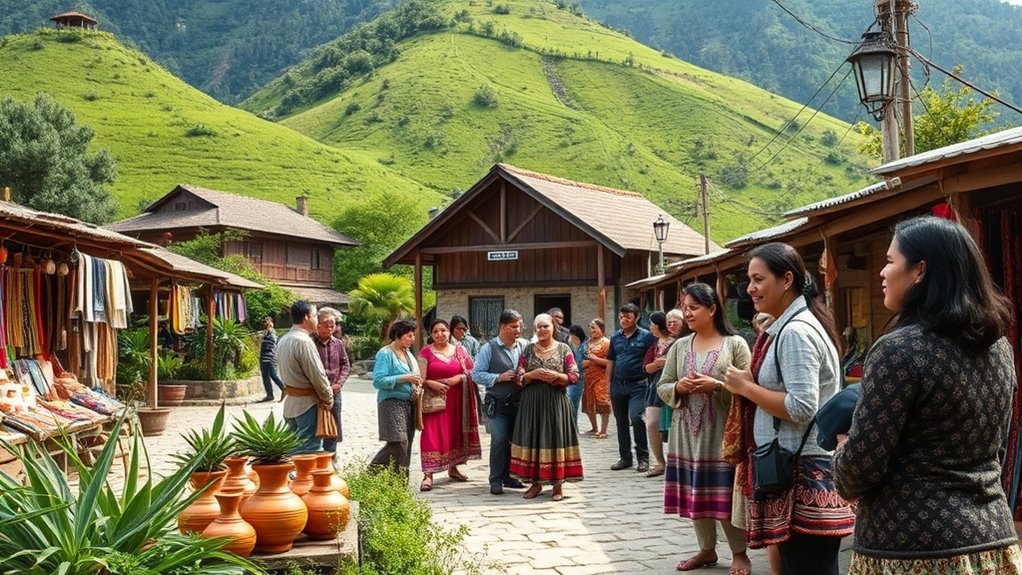Community-based tourism puts local residents in charge of managing tourism activities, ensuring that profits stay within the community. This approach creates jobs, supports local crafts, and boosts small businesses, helping the economy grow sustainably. It also promotes cultural preservation by showcasing traditions and heritage. As you explore further, you’ll discover how this model sustains communities and fosters genuine cultural exchanges that benefit everyone involved.
Key Takeaways
- Empowers local residents and communities to directly manage tourism activities and share profits.
- Generates employment opportunities in guiding, crafts, hospitality, and other local services.
- Keeps tourism revenues within the community, fostering economic growth and sustainability.
- Funds local development projects such as schools, healthcare, and infrastructure.
- Diversifies income sources, reducing dependency on external businesses and supporting long-term economic resilience.

Have you ever wondered how tourism can benefit both travelers and local communities? Community-based tourism offers a powerful answer. It’s a model that puts control firmly in the hands of local residents, ensuring that the profits generated from visitors benefit the entire community. Instead of large corporations reaping most of the rewards, community-based tourism empowers villages, cooperatives, and local collectives to manage and benefit from tourism activities directly. This approach fosters authentic experiences for travelers, rooted in local culture and traditions, giving you a genuine insight into the community’s way of life. You get the chance to participate in traditional crafts, local festivals, or culinary practices, which creates a meaningful cultural exchange that promotes mutual understanding and respect.
Community-based tourism empowers locals and offers authentic cultural experiences for travelers.
This form of tourism isn’t just about cultural immersion; it also has significant environmental benefits. Local communities often prioritize sustainable resource management, conserving their natural surroundings and ecosystems. This ensures that tourism doesn’t harm the environment but instead contributes to its preservation. For example, community-led conservation projects often focus on ecosystem preservation, ensuring the longevity of natural resources for future generations. Many community-based projects actively promote eco-friendly practices, such as waste reduction, renewable energy use, and ecosystem protection, making your travel experience more responsible and sustainable. Incorporating sustainable practices can also help communities adapt to changing environmental conditions and mitigate impacts like climate change.
Economically, community-based tourism can be a game-changer for local residents. When profits stay within the community, it fosters economic empowerment and improves living standards. You’ll find that this model creates numerous job opportunities for local people, from guiding tours and running guesthouses to preparing traditional meals or selling handcrafted souvenirs. These jobs help diversify income sources, providing communities with a sustainable way to support themselves long-term. Because these experiences are often more affordable, they attract budget-conscious travelers, allowing you to enjoy unique, authentic adventures without overspending. The revenues generated aren’t just for a few; they help fund community projects, schools, and health services, further boosting local development.
Community-based tourism also plays a crucial role in preserving local culture. It instills pride among residents, encouraging the preservation of customs, language, and heritage. When community members actively showcase their traditions, it helps safeguard their cultural identity for future generations. As a traveler, you benefit from engaging directly with locals, gaining insights into their beliefs and customs that are rarely accessible through conventional tourism. This direct involvement fosters respect and understanding, enriching your experience and fostering a sense of connection.
Frequently Asked Questions
How Can Local Communities Ensure Sustainable Tourism Practices?
You can guarantee sustainable tourism practices by actively involving your community in decision-making, promoting environmental and cultural preservation, and prioritizing eco-friendly initiatives. Engage local leaders and indigenous groups to manage tourism responsibly and educate visitors about respecting local customs. Focus on creating diversified income sources, supporting local businesses, and maintaining natural resources. By doing so, you’ll foster a balance that benefits your community economically, culturally, and environmentally for the long term.
What Training Do Community Members Need to Participate?
Imagine a community planting seeds for future growth—that’s what training does. You need skills in developing authentic tourism products, marketing, and delivering excellent experiences. You also require leadership and conflict resolution abilities to manage diverse groups. With proper training, you become the gardener nurturing these seeds, ensuring sustainable practices thrive. This prepares you to actively participate, contribute, and help your community flourish through responsible tourism.
How Does Community-Based Tourism Impact Local Culture Preservation?
You’ll see that community-based tourism helps preserve local culture by generating income for festivals, sites, and traditions, making it easier to maintain and restore them. It empowers residents to control tourism, protecting sacred spaces and sharing authentic customs. This approach encourages teaching traditional arts, languages, and crafts to younger generations, ensuring their survival. Plus, it promotes environmental and cultural respect, fostering a deeper appreciation and safeguarding your community’s unique heritage for future generations.
What Are Common Challenges Faced by Community Tourism Initiatives?
You face challenges like environmental degradation if tourism isn’t managed sustainably. Limited resources and local control can hinder project success. Balancing tourism growth with cultural preservation is tough, especially when commercialization threatens authenticity. You also encounter social divisions and community resistance. Additionally, steering policies and securing government support require effort. Effective collaboration, community involvement, and sustainable practices are key to overcoming these obstacles and ensuring tourism benefits everyone involved.
How Can Tourists Support Community-Based Tourism Effectively?
You can make a real difference by supporting local communities directly. When you choose tours managed by residents, buy handcrafted souvenirs, and stay in community-run accommodations, you’re putting your money where your mouth is. Respect local customs, minimize waste, and participate in cultural events. Sharing your positive experiences on social media and providing feedback helps boost community visibility. Remember, actions speak louder than words—your support can truly empower local livelihoods and preserve their culture.
Conclusion
By supporting community-based tourism, you help lift local economies and preserve cultural heritage. Your choices can make a real difference, empowering communities and fostering sustainable growth. Remember, “A rising tide lifts all boats”—when you choose to travel responsibly, everyone benefits. So, next time you explore a new place, consider how your visit can create positive change. Together, we can build a future where tourism nurtures and sustains local communities for generations to come.









